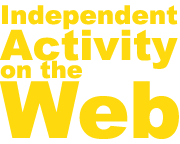- Pre-Primary «
- Independent Activity « Details
Independent Activity

Independent of potential
presidential
candidates, their advocates (and sometimes
their opponents) are active on the Web working to spread the word.
Independent sites include active communities with a number of
contributors, others that are the handiworks of one or two dedicated
supporters,
and more one-dimensional, static sites that are effectively online
brochures or broadsides.
Some sites are framed as "draft" efforts designed to
show and foster support. These may seek to identify state
coordinators and build active communities, or they can be simple online
petitions. Probably the most frequent sites are those done by an
individual or a small group of supporters that have frequent postings
on a presidential prospect's activities. These have an element
of
fan club boosterism, and tend to echo or
repeat content from a potential candidate's official site, but others
can be more
thoughtful or thought-provoking. On the flip side are attack
sites highlighting negative aspect of a presidential prospect's
record. Also noted were a couple of sites that are seeking to
raise money in the event a hopeful gets in the race. Finally
there are also less serious, peripheral sites put up to hawk
bumperstickers or to draw traffic to another website.
Independent sites range
in sophistication from highly polished websites
communicating across a number of platforms (Facebook, Twitter, YouTube,
MeetUp groups and so forth) to simple blogs. Note that this
survey does not
delve into Facebook activity, although that does merit serious
examination.
Content on independent sites typically includes
recent
articles and video clips, oftentimes there is a
comment or discussion component, and sometimes there may be merchandise
available. Independent on-line efforts
can occasionally
lead
to
off-line
activity
such
as
information
tables at a political
conferences or meetings.
The independent sites typically have
limited
lifespans. Some peter
out as the authors run into time constraints or lose interest. If the
principal makes it
clear that he or she will not be a candidate or announces as a
candidate the dynamics change, and the motivation disappears.
In the 2012 pre-campaign period, 2009-10, former Gov. Sarah Palin inspired far and away the most activity. Supporters of Rep. Ron Paul and former Gov. Mike Huckabee were active. Former Gov. Mitt Romney has inspired a range of activity. "Mitt Romney Central" was one of the best of the supporter blogs. A "Why Romney" site went up to correct false claims, and, on the opposing side, "Multiple Choice Mitt" featured side by side video clips to argue that the Romney is "on every side of every issue." Many prospects inspired draft efforts; some of these were fairly static. Gov. Mitch Daniels probably inspired the most sustained grassroots activity while Gov. Chris Christie may have inspired the most talk. Meanwhile, Govs. Tim Pawlenty and Haley Barbour, despite being seen as leading prospects, inspired very minimal activity (for Pawlenty there was one site put up by an Iowa county GOP chair that was not subsequently updated and only a 2008 Barbour for VP sited was observed).
It is
interesting to consider what effect all this activity has. Is
there a correlation between the amount of independent
pre-campaign/pre-primary
activity and the success or lack of success a campaign may encounter
should the individual decide to become a candidate? Can a draft
effort actually persuade a reluctant individual to get in the race?
Bachmann
|
Cain
| Christie
| Daniels
| DeMint
| Gates
| Gingrich
| Huckabee
| Huntsman | McCotter
| Palin | Paul
| Pawlenty | Pence
| Perry | Romney
| Rubio
| Santorum
| Trump

